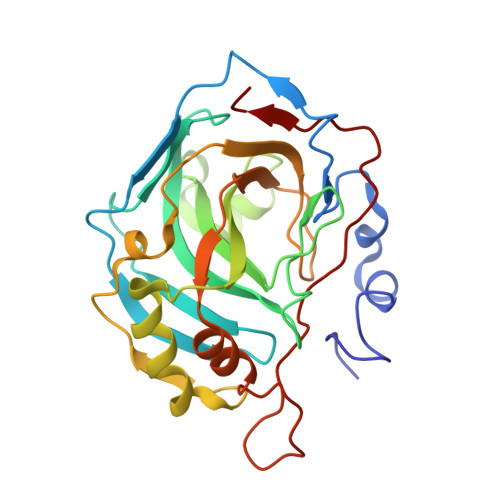Water Networks in Fast Proton Transfer during Catalysis by Human Carbonic Anhydrase II.
Mikulski, R., West, D., Sippel, K.H., Avvaru, B.S., Aggarwal, M., Tu, C., McKenna, R., Silverman, D.N.(2013) Biochemistry 52: 125-131
- PubMed: 23215152
- DOI: https://doi.org/10.1021/bi301099k
- Primary Citation of Related Structures:
3TVN, 3TVO, 4IDR - PubMed Abstract:
Variants of human carbonic anhydrase II (HCA II) with amino acid replacements at residues in contact with water molecules in the active-site cavity have provided insights into the proton transfer rates in this protein environment. X-ray crystallography and (18)O exchange measured by membrane inlet mass spectrometry have been used to investigate structural and catalytic properties of variants of HCA II containing replacements of Tyr7 with Phe (Y7F) and Asn67 with Gln (N67Q). The rate constants for transfer of a proton from His64 to the zinc-bound hydroxide during catalysis were 4 and 9 μs(-1) for Y7F and Y7F/N67Q, respectively, compared with a value of 0.8 μs(-1) for wild-type HCA II. These higher values observed for Y7F and Y7F/N67Q HCA II could not be explained by differences in the values of the pK(a) of the proton donor (His64) and acceptor (zinc-bound hydroxide) or by the orientation of the side chain of the proton shuttle residue His64. They appeared to be associated with a reduced level of branching in the networks of hydrogen-bonded water molecules between proton shuttle residue His64 and the zinc-bound solvent molecule as observed in crystal structures at 1.5-1.6 Å resolution. Moreover, Y7F/N67Q HCA II is unique among the variants studied in having a direct, hydrogen-bonded chain of water molecules between the zinc-bound solvent and N(ε) of His64. This study provides the clearest example to date of the relevance of ordered water structure to rate constants for proton transfer in catalysis by carbonic anhydrase.
Organizational Affiliation:
Department of Pharmacology, University of Florida, Gainesville, FL 32610, USA.















